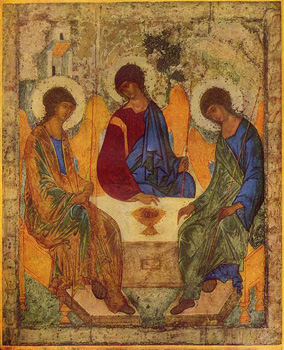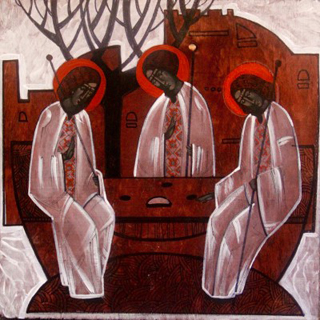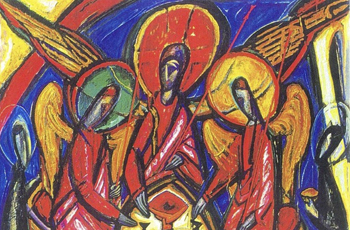For Sunday June 16, 2019
Lectionary Readings (Revised Common Lectionary, Year C)
Proverbs 8:1-4, 22-31
Psalm 8
Romans 5:1-5
John 16:12-15
Let’s face it: Trinity Sunday is a hard sell. While most Christian festivals honor dramatic events (Jesus’s birth, the Resurrection, the coming of the Holy Spirit at Pentecost), Trinity Sunday asks us to celebrate an idea. A theological abstraction. Worse, it asks us to celebrate an idea we can’t wrap our heads around, no matter how hard we try.
If you’re like me, you’ve been at the receiving end (or the giving end) of many well-meaning but inadequate attempts to explain the three-in-one: “The Trinity? Oh, well, it’s sort of like water! You know, liquid, vapor, and ice? Three phases, one entity? The Trinity is like that!” Or, “Think of a tree! The roots, the trunk, and the branches. Three parts, one tree. Or an egg. The shell, the eggwhite, and the yolk. Or a triangle. Or a three-leaf clover. Or a human family — father, mother, and child."
All of these analogies fall short, and none of them address the deeper question: Why should we care? What difference does the three-in-one make? Fine, God is Father, Son, and Holy Spirit. But so what?
I don’t mean to be trite, but the “so-what?” question is an essential one. Many of us are tired. Physically, emotionally, and spiritually. Some of us are struggling with illness. Or loss. Or troubled relationships. Or financial hardship. Some of us are lonely, disappointed, angry, and heartsick. Some of us are barely hanging onto belief in one God. And now the Church wants us to contemplate three? Why?
In our Gospel reading this week, Jesus tells his disciples, “I still have many things to say to you, but you cannot bear them now. When the Spirit of truth comes, he will guide you into all the truth; for he will not speak on his own, but will speak whatever he hears, and he will declare to you the things that are to come.”
I still have many things to say to you, but you cannot bear them now. Can we pause for a moment and hear the tenderness in those words? The kindness? The depth of patience, perception, and forbearance Jesus offered to his disciples? He didn’t burden their frightened, skittish, saturated souls with more than they could handle. Instead, he promised them the Holy Spirit, the Spirit of truth, the Spirit of ongoing revelation. That Spirit would slowly guide the disciples — and by extension, all of us — into a fuller knowledge and comprehension of everything Jesus left unsaid.
 |
As I contemplate the three-in-one this week, I’m finding Jesus’s promise a safe and gentle place from which to begin. Meaning, I don’t have to understand everything right now. I don’t have to find the perfect analogy or metaphor to explain the three-fold fullness of God. The Trinity is not fodder for bumper sticker summaries or clever internet memes; it is a great and holy mystery, and my first job is to stand in humility before it. To explore the nature of God's selfhood is to come to the end of what human language can illuminate. It is to become speechless. It is fall to our knees and say, “I cannot hold the singularity, the otherness, the strangeness of this God. I cannot domesticate him. I cannot tame him." All we can do is seek the truth with our whole hearts, and trust that Jesus’s promise holds. All we can do is await the Spirit who will come and reveal God's truth to us in God's time.
In our divided and polarized culture, it’s easy to imagine that we have the monopoly on God. That our articulation of faith, our liturgy, our denomination, and our worship practices capture the best version of who God is and what God desires. One thing the Trinity does by its very complexity is challenge this assumption. The truth of God will always exceed us. The truth of God will always be more than our tiny, easily overwhelmed minds can bear. The truth of God will always confront, convict, and remake us, even as it soothes and affirms us.
So we begin our celebrations with the humble acknowledgement that we are out of our depth. But now what? Is there anything we can say with assurance, or honor with abandon on this Trinity Sunday? Franciscan priest and theologian Richard Rohr argues that caring about the Trinity requires orienting ourselves in a new way: “Don’t start with the One and try to make it into Three,” he writes in his book, The Divine Dance. “Start with the Three and see that this is the deepest nature of the One.”
Start with the Three and see that this is the deepest nature of the One. What might it look like to follow Rohr's advice? What will we discover about God’s character, God’s personality, God’s priorities, and God’s reality, if we see threeness as the ground and essence of God’s being? Here are a few possibilities:
- We’ll see that God is dynamic. If God is triune, he does not exist in stasis. Rather, God’s self is fluid. God moves. Or to use Rohr’s language again: God flows, and God is flow. God dances, and God is dance. Regardless of whether we'll learn to tolerate the discomfort of divine fluidity or not, we worship a God who is always on the move, always spilling over, always organic, always a surprise. His coherence and his unity do not require him to be rigid. “Expand do not contract God,” Kenn Storck writes in his poem, “The Holy Trinity,” “For God is the Great Iconoclast.”
- We’ll see that God is diverse. If God exists in three persons, then each person has his (or her) own way of embodying and expressing goodness, beauty, love, and righteousness. As Rohr puts it, the Trinity affirms that there is an intrinsic plurality to goodness. “Goodness isn’t sameness,” he writes in The Divine Dance. “Goodness, to be goodness, needs contrast and tension, not perfect uniformity.” If God can incarnate goodness through contrast and tension, then it’s worth asking why we can’t. Or won’t. Why do we fear difference so much when difference lies at the very heart of God’s nature?
 |
- We’ll see that God is communal. It’s one thing to say that God values community. Or that God thinks community is good for us. It’s altogether another to say that God is community. That God is relationship, intimacy, connection, and communion. If God is interactive at God’s very heart — if Three is the deepest nature of the One — then what are we doing when we isolate ourselves from each other? When we decide to go it alone? When we privilege independence and autonomy over companionship and mutuality? If the Trinity really is more than a bit of dusty doctrine the early Church fought over, then we dare not take lightly the life-changing power of the communal. God is Relationship, and it is only in relationship that we'll experience God’s fullness.
- We'll see that God is hospitable. In the 15th century, Russian iconographer Andrei Rublev created “The Hospitality of Abraham,” also known as “The Trinity,” one of the most well known and beloved icons in Christendom. In it, the Father, the Son, and the Holy Spirit (depicted as the three angels who appeared to Abraham near the great trees of Mamre), sit around a table, sharing food and drink. Their faces are nearly identical, but they’re dressed in different colors. The Father wears gold, the Son blue, and the Spirit green. The Father gazes at the Son. The Son gazes back at the Father, but gestures towards the Spirit. The Spirit gazes at the Father, but points toward the Son with one hand, and opens up the circle with the other, making room for others to join the sacred meal. As a whole, the icon exudes adoration and intimacy — clearly, the three persons around the table respect and enjoy each other. But it also exudes openness. There is space at the table for the viewer of the icon. For me. For us. As if to say, the point of the great Three-in-One is not exclusivity — God is not a middle school clique — but rather, radical hospitality. The point of the Three is always to add one more, to extend the invitation, to make the holy table more expansive and more welcoming. In fact, the deeper the intimacy between the Three grows, the roomier the table grows. Likewise, the closer we draw to the adoration of the Three, the wider and more hospitable our hearts grow towards the world.
- And finally, we'll see that God is love. The Trinity at its heart is an expression of deep, unfaltering, and life-giving love between the Father, the Son, and the Holy Spirit. The relationship between the persons of the Godhead is not a relationship of domination, power-mongering, manipulation, or jealousy. It is a relationship of unselfish, sacrificial love. Which begs the question: if God’s very being is grounded in love, and we are created in God’s image, then who are we? What are we? Are we, like the Triune God whose imprint we bear, creatures motivated by love? If we are not, then what are we doing with our lives? What does our piety amount to?
 |
Why should we care about the three-in-one? We should care because we are children of the Trinity. The children of a mysterious, fluid, diverse, communal, hospitable, and loving God who wants to guide us into the whole truth of who God is and who we are. We should care because the mystery of the Trinity has the power to transform our hearts, leading us towards coherence and dynamism, unity and diversity. This week and always, may our lives reflect the truth and beauty of the Triune God.
Debie Thomas: debie.thomas1@gmail.com
Image credits: (1) Wikimedia.org; (2) Cathedral of the Incarnation; and (3) Marginalia; Los Angeles Review of Books.





